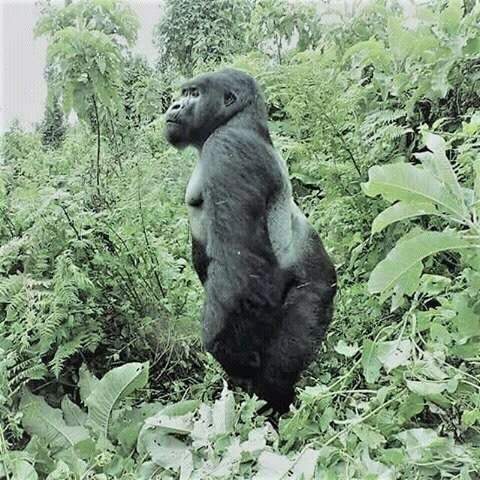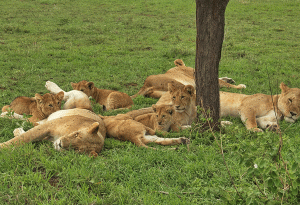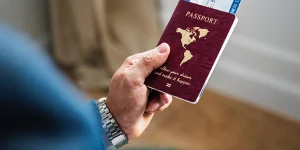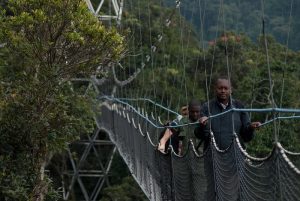A close encounter with gorillas is unlike any other wildlife experience in the world. Unlike safaris, where animals are observed from the safety of a vehicle, gorilla trekking takes visitors directly into the dense forests of Africa, where these magnificent primates live freely and naturally. A typical encounter begins with an early morning trek, which often lasts between one and four hours, depending on the location of the gorillas. Once trackers and rangers guide the group to the gorilla family, visitors are allowed to spend up to one precious hour with them. Close Encounter with the Gorillas
During this time, travelers can observe gorillas feeding on leaves, grooming one another, and playing among the trees. Sometimes, juveniles display curiosity and approach humans—though strict rules require visitors to stay calm and avoid sudden movements. The experience is deeply immersive because trekkers are on the gorillas’ terms, sharing space in their natural environment rather than observing from afar. This unique intimacy is why gorilla trekking is described as life-changing, and it is consistently ranked as one of the most extraordinary wildlife encounters on earth. Close Encounter with the Gorillas
How Close Can You Actually Get to a Gorilla?
Tourists are required to keep a minimum distance of seven meters (about 23 feet) from gorillas. This buffer reduces the risk of transmitting human diseases, which gorillas are highly susceptible to, and also helps minimize stress on the animals. Rangers strictly enforce this rule during every trek. However, gorillas do not always recognize human-imposed boundaries. Juveniles, in particular, are playful and may approach tourists out of curiosity. In rare instances, young gorillas have gently touched visitors before quickly returning to their group.
Despite these close moments, visitors must never initiate contact. Gorillas, especially dominant silverbacks, can be unpredictable and powerful. If a gorilla comes closer than expected, trekkers are instructed to remain still, crouch down to appear less threatening, and avoid direct eye contact with the silverback. This respectful distance not only keeps tourists safe but also ensures gorillas continue to feel comfortable with human presence.
Where Are the Best Places to Have a Gorilla Encounter?
Gorilla encounters take place in only three countries: Uganda, Rwanda, and the Democratic Republic of the Congo (DRC). Each destination offers a slightly different experience, and choosing the right one depends on preferences for cost, accessibility, and adventure level.
- Uganda is home to Bwindi Impenetrable National Park and Mgahinga Gorilla National Park. Bwindi alone shelters nearly half of the world’s remaining mountain gorilla population, with an estimated 459 individuals. Treks here often involve rugged terrain and thick vegetation, but the diversity of gorilla families and the chance to witness unique behaviors—such as climbing trees in search of fruit—make it highly rewarding.
- Rwanda is the most accessible option. Volcanoes National Park lies just a few hours from Kigali International Airport, making it convenient for travelers with limited time. The park is also where Dian Fossey carried out her groundbreaking gorilla research, and today it is one of the best-managed gorilla tourism destinations. Rwanda is famous for its well-organized treks, high conservation standards, and luxury lodge experiences.
- The Democratic Republic of the Congo (DRC) offers gorilla encounters in Virunga National Park. This option is more adventurous and less crowded than Uganda or Rwanda, appealing to those seeking raw wilderness. Virunga is also home to both mountain gorillas and eastern lowland gorillas, making it a unique destination for primate enthusiasts.
Why Is Gorilla Trekking So Special and How Does It Support Conservation?
Gorilla trekking is not just about adventure—it is also a crucial pillar of conservation. Mountain gorillas are critically endangered, with just over 1,000 remaining in the wild. Revenue from trekking permits directly funds national park operations, anti-poaching patrols, and veterinary care for injured or sick gorillas. Additionally, a portion of the fees goes to local communities, providing schools, healthcare facilities, and employment opportunities.
This community-based approach encourages local people to protect gorillas rather than hunt them or clear their habitats for farming. In fact, the steady increase in gorilla numbers over the past three decades is one of the greatest success stories in wildlife conservation. Trekking is therefore more than a tourist activity—it is an investment in the future of a species that once teetered on the brink of extinction.
What Safety Measures and Etiquette Should Visitors Follow?
Before every trek, visitors attend a mandatory briefing session where park rangers explain the rules for interacting with gorillas. These guidelines are essential for the safety of both humans and gorillas. Tourists must:
- Maintain a distance of at least seven meters.
- Avoid eating, drinking, or smoking near gorillas.
- Keep voices low and movements slow.
- Refrain from flash photography.
- Stay with the group at all times.
- Never touch a gorilla, even if one approaches.
In addition, anyone with flu, cough, or other contagious illnesses is barred from trekking to protect gorillas from human-transmitted diseases. Groups are deliberately kept small—usually limited to eight people per gorilla family—to minimize environmental impact and prevent overwhelming the animals.
When Should Travelers Plan Their Gorilla Trek?
Gorilla trekking is available year-round, but the best time to visit is during the dry seasons: June to September and December to February. During these months, trails are less muddy, and treks are generally easier. However, gorilla trekking in the rainy season has its advantages as well. The forest is lush and vibrant, and because food is abundant, gorilla families often stay closer to the trailheads, reducing trekking times.
Regardless of the season, permits are limited and highly sought after. It is advisable to book permits six to nine months in advance, especially if traveling in peak season. This ensures availability and allows travelers to secure their preferred trekking dates.
What Are the Permit Costs and Requirements?
Gorilla trekking permits vary by country and are a significant portion of the overall cost.
- In Rwanda, permits cost around $1,500 per person, reflecting the country’s investment in conservation and its emphasis on a luxury tourism model.
- In Uganda, permits are currently priced at $700 per person, making it a more affordable option without compromising on the experience.
- In the DRC, permits are the least expensive, averaging $400 per person, though treks here may involve greater logistical challenges.
Permits must be purchased in advance, either through the official wildlife authorities or authorized tour operators. Visitors should also carry a valid passport for identification during the trek.
How Many Mountain Gorillas Remain in the Wild Today?
Current estimates place the global population of mountain gorillas at just over 1,000 individuals. They are split between two main habitats: the Bwindi Impenetrable National Park in Uganda and the Virunga Massif, which spans Rwanda, Uganda, and the DRC. While these numbers are small, they reflect a remarkable recovery from the 1980s when only about 250 gorillas remained in the wild.
Thanks to continuous conservation efforts, gorilla numbers have grown steadily. This progress makes mountain gorillas the only great ape species whose population is not currently declining. However, they remain critically endangered, requiring ongoing protection and international collaboration.
What Challenges Do Gorilla Populations Face?
Despite conservation successes, gorillas still face significant threats. Habitat loss remains a major concern as forests are cleared for agriculture and settlement. Poaching, though less common than in the past, still occurs—sometimes targeting gorillas directly or through snares set for other wildlife. Disease is another serious issue; gorillas share 98% of their DNA with humans, making them vulnerable to many human illnesses. Even a simple cold can be deadly to a gorilla.
Armed conflict in regions like eastern Congo has also disrupted conservation work and increased risks for gorillas and rangers. International agreements such as the Gorilla Agreement aim to strengthen cross-border cooperation in protecting gorilla habitats, combating poaching, and raising global awareness about their plight.
What Should You Bring and Wear for Gorilla Trekking?
Preparing properly ensures a safe and comfortable trek. Essential items include:
- Sturdy hiking boots for steep and muddy terrain.
- Lightweight, long-sleeved clothing to protect against insect bites and stinging plants.
- Rain jacket and waterproof gear, since rain is common in tropical forests.
- Gloves to help grip vegetation during climbs.
- Insect repellent and sunscreen for comfort.
- Plenty of drinking water and snacks for energy during the trek.
Hiring a porter is also highly recommended. For a small fee, porters carry bags and assist on difficult paths. This not only eases the trek but also provides income to local communities, further supporting conservation.
How Does Gorilla Behavior Influence Trekking Experience?
Observing gorilla behavior up close is one of the most fascinating aspects of trekking. Gorillas live in cohesive family groups led by a dominant silverback, who is responsible for protecting the group and making decisions about movement. Daily activities include feeding on leaves, stems, and fruit; grooming each other; and resting together.
Young gorillas are particularly entertaining, often engaging in playful wrestling, climbing, and mock chest-beating. These behaviors are not just amusing but also crucial for their social development. Seeing a silverback rise to his full height and beat his chest is a powerful reminder of their strength, while moments of tenderness—such as mothers cradling infants—highlight their intelligence and close family bonds.
What Else Do People Search for about Gorilla Encounters?
Beyond the logistics of trekking, people often ask specific questions about gorilla behavior and safety. Some of the most searched include:
- What happens if a gorilla charges at you? Rangers advise staying calm, avoiding eye contact, and crouching low to show submission. Running can provoke pursuit.
- Can you make eye contact with a gorilla? Direct, prolonged eye contact can be seen as a threat. Visitors are encouraged to look respectfully without staring.
- How strong is a gorilla compared to a human? A silverback is estimated to be 6–10 times stronger than an adult human, making respect and caution essential.
- Do gorillas ever attack humans? Attacks are rare during guided treks because gorilla families are habituated, meaning they are accustomed to human presence. However, silverbacks may bluff-charge to assert dominance if they feel threatened.
These FAQs reflect the curiosity and concerns many travelers have, and addressing them helps prepare visitors for a safe and rewarding experience.
Final Thoughts
A close encounter with gorillas is more than just a wildlife experience—it is a journey into one of the last strongholds of true wilderness. Trekking through misty forests to share space with a gorilla family is humbling, awe-inspiring, and deeply impactful. At the same time, every trek supports conservation and local communities, ensuring that gorillas continue to thrive for generations to come. Close Encounter with the Gorillas
For travelers seeking an adventure that combines raw nature, conservation, and unforgettable memories, few experiences in the world rival standing just meters away from a family of wild mountain gorillas.




